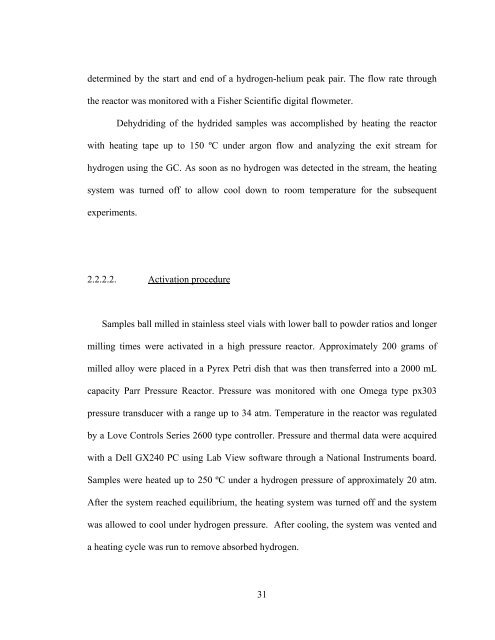You also want an ePaper? Increase the reach of your titles
YUMPU automatically turns print PDFs into web optimized ePapers that Google loves.
determined by the start and end of a hydrogen-helium peak pair. The flow rate through<br />
the reactor was monitored with a Fisher Scientific digital flowmeter.<br />
Dehydriding of the hydrided samples was accomplished by heating the reactor<br />
with heating tape up to 150 ºC under argon flow and analyzing the exit stream for<br />
hydrogen using the GC. As soon as no hydrogen was detected in the stream, the heating<br />
system was turned off to allow cool down to room temperature for the subsequent<br />
experiments.<br />
2.2.2.2. Activation procedure<br />
Samples ball milled in stainless steel vials with lower ball to powder ratios and longer<br />
milling times were activated in a high pressure reactor. Approximately 200 grams of<br />
milled alloy were placed in a Pyrex Petri dish that was then transferred into a 2000 mL<br />
capacity Parr Pressure Reactor. Pressure was monitored with one Omega type px303<br />
pressure transducer with a range up to 34 atm. Temperature in the reactor was regulated<br />
by a Love Controls Series 2600 type controller. Pressure and thermal data were acquired<br />
with a Dell GX240 PC using Lab View software through a National Instruments board.<br />
Samples were heated up to 250 ºC under a hydrogen pressure of approximately 20 atm.<br />
After the system reached equilibrium, the heating system was turned off and the system<br />
was allowed to cool under hydrogen pressure. After cooling, the system was vented and<br />
a heating cycle was run to remove absorbed hydrogen.<br />
31



